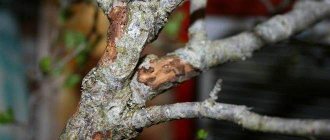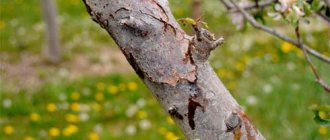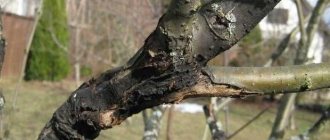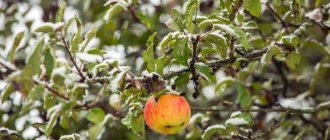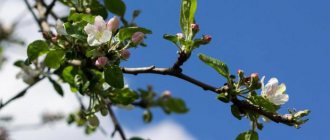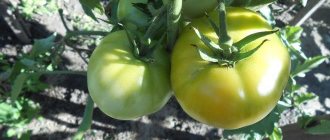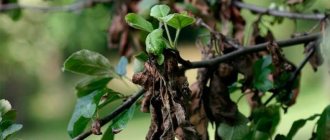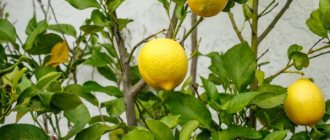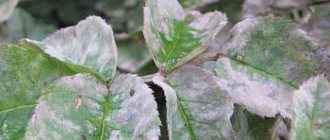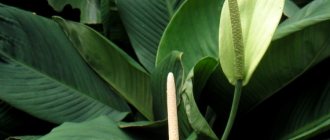What harm can rodents cause on the site?
Most often, mice appear on the site in late autumn and winter. With the onset of cold weather, mice may appear in summer cottages in search of food, the reserves of which are running out by winter. Their favorite food is the bark of apple trees because it does not have a bitter taste, unlike other fruit trees. Mice, hares, and rabbits can destroy all the seedlings in the garden in one season. Most often, mice and hares gnaw the bark of young seedlings, since their bark is softer.
Field mice have small teeth, so they can only gnaw through the top layer of bark. Massive invasion of mice can lead to damage to the cambium layer, which is located between the bark and the core of the trunk. Hares almost always gnaw through the apple tree down to the cambium. The layer under the bark is responsible for conducting nutrients and water; if it is damaged, the development of the tree is disrupted and productivity decreases. If the cambium is 80% damaged, the tree cannot be restored.
Bark is the protective covering of a tree that protects its interior. Its damage is an entry point for bacterial and fungal infections. If only the bark is damaged, restoring the tree is much easier. Pests more often attack trees in winter; they dig holes in the snow and feed on the part of the apple tree that is under the snow, including the roots. Therefore, damage from rodents is discovered after the snow melts.
If rodents fed on roots in winter, then in early spring you can notice that the seedling has leaned to the side. If the root system is damaged by 80% or more, the tree will not be able to stay in the soil and will collapse. It is no longer possible to restore it. If the roots are half eaten, the amount of substances from the soil for the development of the tree is reduced, which affects the condition of the branches, leaves, and the future harvest, which may not exist. The apple tree can be treated as soon as the frosts stop; until then, the damaged area can be covered with garden varnish and wrapped with plastic wrap.
Important! The stronger the ring damage to the apple tree, the less likely it is to save the seedling.
How to help a tree if the trunk or bark is damaged.
You can regularly fight insect pests, dig in and fertilize, but if the trunk turns black with wounds and hollows, is covered with furrows of cracks and abrasions, the tree will hurt and possibly die.
Wounds are a gateway to infection, cracks are reliable shelters and hearty dining rooms for hordes of insects. Damage to the trunk after improperly cutting a branch When
you examine the trees in your garden, you can see damage on trunks and large branches such as:
Schisms.
Causes:
Splits between the trunk and the main skeletal branches appear due to the angle between them being too small. The heaviness of snow or fruit provokes the appearance of tears and splits.
Fruit tree. Incorrect arrangement of skeletal branches.
Prevention:
Formation of the tree crown. The angle of departure of the skeletal branches from the trunk should not be less than 30°. Young branches growing at a smaller angle are pulled back and left in a fixed position until they are completely lignified. Attention: when tying branches, make sure that the rope does not cut into the bark. In old trees, improperly growing branches will have to be cut down so as not to destroy the entire tree. The plasticity of the bark and wood of old trees is not great; they are most susceptible to splitting.
These photos show a sufficient angle of departure of the branches from the trunk of the fruit tree
Cracks.
Causes:
- During very severe frosts, frost cracks may often appear on young, recently planted trees. In mature fruit trees suitable for growing in this area, the bark can withstand low temperatures, but can crack under sudden temperature fluctuations.
Frost crack on apple berry tree (lat. Malus baccata)
- Often cracks appear as a result of bark burns received by the tree in early spring. Dark tree trunks against the background of white snow become very hot. Sharp fluctuations in day and night temperatures, either awakening or freezing of cells and tissues, lead to disruption of their structure. Cracks appear. In some places, especially on the southern side, sections of the bark may die off from burns. They become brown or reddish, soft to the touch, and the bark separates from the wood.
Prevention:
- The trunks of young seedlings are tied for the winter. In this case, the temperature around the barrel practically does not increase, but the barrel does not freeze or get burned.
- Painting trunks with whitewash will help protect trees from burns. The trunks of fruit trees should be whitened at the end of February or beginning of March. Whitewashing the trunks in May serves only a decorative function.
You can find information that cracks form on trunks overgrown with lichens because moisture penetrates under them. Even more often they write that because of lichens, decay begins and diseases develop. This is just one of many myths about the garden.
Large wounds and damage to the cortex.
Causes:
Tree bark, especially young bark, attracts hares, mice and other rodents during a hungry winter. Detachment of large areas of bark occurs in very severe winters, due to icing and burns. Without emergency help for large, especially ring-shaped damage to the bark, the tree will die.
Apple tree trunk damaged by hares
Prevention:
Tying young trees with nylon and covering material. From experience, the best material for protecting tree trunks is found in every home. Just don't laugh, these are women's tights.
Rodents do not like the smell of elderberry and mint. “Bouquets” of these plants are laid out around the trunk or tied to it.
Treatment:
You can save a tree that is “ringed” (with the bark removed around the circumference) or with large damage to the bark by grafting with a bridge. The bark is cut above and below the damaged area. Cuttings are prepared of such length that, after being placed in the upper and lower cuts in the bark, they bend slightly in an arc over the damaged area. An oblique, sharp and even cut is made on the cuttings on both sides, and they are inserted with the cuts towards the trunk behind the cut bark. The number of cuttings depends on the size of the damage and the diameter of the trunk; they are placed every 5-7 cm above the damaged area. When all the cuttings are installed, they are tied tightly around the trunk at the top and bottom. In order for the wound to heal quickly and completely, the wound is cleaned down to healthy tissue. The cuttings are cut lengthwise along the core, the cut is placed on the wound, and oblique cuts of the ends of the cutting are inserted into cuts in the bark above and below the wound. Along the entire length, the cuttings are tightly tied to the trunk. With this method of regrafting, the wounds heal completely and the damaged wood does not die.
Hollow.
Causes:
Hollows appear in places where bark damage has not been treated in a timely manner. Chipping or improper cutting of a branch leads to rotting of the knot and nearby wood, and a hollow appears.
Cancer often develops on such damage to the trunk.
Prevention:
Regular care of tree bark, proper cutting of branches, processing of cuts.
Treatment:
The entire surface of the hollow must be carefully cleaned with a knife down to living tissue. It is enough to cover small depressions in the trunk with garden varnish. Large hollows are smeared with garden varnish or resin over the cleaned fabric. The hollow is then filled with a wet mixture of cement and sand.
Weakened trees with various damage to the bark are susceptible to black cancer. This dangerous and very serious fungal disease is very difficult to treat and most often leads to the death of the tree. Often you have to sacrifice a diseased tree to save the entire garden.
Formation of the crown, pruning, treatment of cuts and damage to the bark, whitewashing of trunks, pruning and destruction of diseased branches, disinfection are preventive measures to protect trees.
_________________________________________________________________________________________
Are all gardening activities beneficial to the garden? Are we doing them right? Three myths about the garden.
__________________________________________________________________________________________
The conditions under which diseases in plants take on epidemic proportions are the same as during the spread of infectious diseases in humans. Epidemic in the garden. It's easier to prevent than to suppress.
___________________________________________________________________________________________
Review of preparations for treating garden diseases in spring. Copper-containing drugs. Which to choose?
___________________________________________________________________________________________
Iron sulfate in the fight against garden diseases, chlorosis and... frost.
#estate #dachawithus
#garden #garden care #preparations for plant protection #plant diseases #garden garden #fruit trees #berry bushes #useful information #dacha #useful tips #country life #garden diseases
How can you save a tree with damaged bark?
The choice of treatment method and apple tree restoration depends on the degree of damage to the seedling. If mice have chewed off a small area of bark without damaging the cambium, medicinal dressings can be applied. If the tree trunk is severely damaged, the movement of sap is disrupted, grafting, regrowth, and engraftment can help.
Application of therapeutic dressings
Using this method, you can save the trunk of a young apple tree with minor damage to the bark, if mice or hares damaged only the top layer and did not reach the cambium. You can restore the apple tree bark before it dries; after that, medicinal dressings will not help. There are many ways to treat with bandages. The five most popular.
Non-infectious wounds
Non-infectious wounds are caused by mechanical damage. Such wounds can be either caused by the gardener during pruning and grafting, or under the influence of external factors - the appearance of sunburn, frost damage, strong winds, excess or lack of moisture and nutrients, damage by rodents, birds and harmful insects.
- The wounds caused during pruning and grafting are treated by the gardener during the procedure, so the trees tolerate them relatively easily. Wounds that appear when branches break off are also immediately noticeable and do not require specific differentiation.
- If the bark peels off in large pieces, and the wound looks as if the tree was doused with boiling water, these are the consequences of temperature changes or sunburn. To avoid this, in the fall trees must be whitened with slaked lime, garden whitewash or water-based paint.
- If the wounds are located at the bottom of the trunk, and the bark looks disheveled and torn into strips, this indicates the presence of rodents in the area. Damage to the upper layer of bark indicates the presence of mice; deeper damage may indicate the work of hares.
- Through holes in the bark are a sign of the presence of woodworms and woodworms. Opening such holes will reveal a cavity in the bark. These wounds require treatment and pest control, as otherwise hollows may form in the wood.
- In mature trees, the bark can renew itself naturally, cracking and peeling. These are the safest wounds; their main feature is the presence of a renewed layer under the old bark. Healthy trees cope with such wounds on their own; they do not require treatment.
Restoring bark on an apple tree for non-infectious wounds
Depending on the cause of the wound, a specific method of treatment and prevention is selected, however, they all require cleansing the tree of dead tissue and disinfecting the open area with copper sulfate (1% solution is prepared from 10 g of dry matter per 1 liter of water).
If damage to the bark exposes the wood, the wound requires the application of a putty of clay and mullein mixed in different proportions. Small wounds can be treated with garden varnish. Whitewash is applied on top of this putty.
How to properly take cuttings for bridge grafting
The graft is taken from healthy trees that do not show signs of disease or damage. Preferably seedlings that have already bear fruit. If there are no such trees, you can cut a branch from the apple tree itself. In the fall, the scion is harvested before the leaves fall, before frosts begin, or in the spring, until the buds swell. In cuttings cut in autumn, the speed of sap movement is reduced, their buds are in a dormant state, and they are activated until spring.
To cut the material, it is better to choose branches growing on the sunny side in the middle of the crown. The cutting should be straight with smooth, healthy bark and several well-formed (not deformed) buds. The length of the scion is about 25 cm, the thickness is about 6 mm. You can cut the branch only with a sharp knife to get an even cut. The angle of the cut is oblique, so that it can be inserted between the bark and the wood during fusion.
How to properly store cuttings for grafting
The scion must be prepared with a reserve, since some of it may die during storage. There are many ways to store both outdoors and at home. On the street, the material is often stored in the ground. To do this, dig a hole about 15 cm deep, fill it halfway with dry sawdust, fold the scion, and sprinkle it with a wet layer of sawdust. After the first frost, the top layer will freeze, after which it needs to be sprinkled with another dry layer, about 25 cm thick, and covered with polyethylene material.
If snow cover remains in the region where you live in winter, you can store the scion in another way. Dig a hole about 25 cm deep, put spruce branches on the bottom, then cuttings and again spruce paws. The top is covered with soil or sawdust. You can mix the soil half and half with sawdust. If it is not possible to store the cuttings outside, they can be placed in the refrigerator, wrapped in a wet cloth and placed in a bag. Under no circumstances should you put them in the freezer - they will freeze and die.
If you have a cellar at home, you can store the graft in pots or wooden boxes. Any container is covered with a bag with holes in the bottom and half filled with wet sand or sawdust. Insert cuttings with the cut side down. Fill the container with sand or sawdust to the brim. When stored in a cellar, cuttings can deteriorate if the temperature and humidity are not maintained. Optimum temperature from 0° to +2°С, humidity from 55 to 70%.
What to do if mice gnawed not only the bark of the apple tree, but also the roots
Mice spoil the roots of seedlings most often in winter, as they dig tunnels under the snow. If the root system is severely damaged, a young tree in the spring may not only begin to dry out, but also lean to the side. Once a tree has leaned, it is impossible to restore it. If the tree stands straight and part of the root system is preserved, you can try to restore it.
In early spring, as soon as the snow melts and the frosts recede, the roots of the apple tree are exposed. Damaged areas are treated with a special Heteroauxin solution. It is a growth stimulator that accelerates the healing process and restoration of the root system. You can buy it at any specialized store. After processing, wood ash is sprinkled on top.
The roots are covered with soil, which is mixed with ash and superphosphate. The soil is compacted to secure the tree and it is tied to a stake. To remove the load from the trunk, you need to cut off about 70% of the side branches. Also, the large crown of the apple tree takes a lot of nutrients and moisture for the formation of buds, leaves, and fruit filling. If you cut them, the root system will recover faster.
Important!
After treating the roots, you need to check the soil for mouse holes to prevent pests from chewing on the roots again.
Why is damage to the bark of apple trees dangerous?
Small mice can disrupt plans for a high-quality harvest next year, into which a lot of effort has been invested. Bark is their favorite treat; if you don't take care of your garden in winter, it can be damaged beyond repair. Of all garden trees, the most favorite are apple trees, especially young ones with soft bark.
It is possible to save a tree with damaged bark, but you need to act immediately. It is important to make every effort to preserve garden “pets” so that in the future they will delight you with a good harvest. Only timely protection will prevent garden plants from dying. It is important to carry out annual preventative maintenance.
Preparing garden varnish to putty damage
Garden varnish is used to treat wounds on apple trees and other fruit trees. They can also be used to treat fusion sites during vaccinations. The putty is an environmentally friendly product. You can buy it ready-made or prepare it yourself. There are many ways to prepare the brew. Experienced gardeners recommend using Zhukovsky or Pashkevich var. The first putty contains 3 components: wax, rosin, lamb fat. Most often, all components are taken in the same quantity, but wax can be taken twice as much.
Wax closes cracks and protects them from moisture and pathogenic flora. Due to the fat, the composition on the trunk does not crack. Rosin gives the composition stickiness so that it adheres tightly to the bark. To prepare, melt all components in separate containers over low heat or a steam bath. While they are hot, mix together and pour into cold water. The mixture does not sink, but floats on its surface. The putty is collected from the water and rolled into a ball. It kneads very easily and has a consistency similar to plasticine. The putty is stored in a dark place, wrapped in oiled paper. During storage, the varnish hardens slightly; before use, it is heated until soft.
The composition of Pashkevich's var includes 4 components:
- rosin - 2 parts;
- yellow wax – 4 parts;
- turpentine – 4 parts;
- rendered fat - 1 part.
First, melt the wax, then add rosin and turpentine, mix until smooth. Lastly, melted fat is added. The composition is poured into a container with cold water and collected into one lump. Stored like Zhukovsky's var. Before using garden varnish, the damaged area is cleaned and can be additionally treated with copper sulfate. After applying the mixture, the section of the trunk is wrapped with natural fabric.
Important!
Instead of garden varnish, you can treat the trunk with biobalms, which are sold in specialized stores; instructions for use are indicated on the packaging.
Cracks in the bark of young trees. Why does the bark crack on young fruit trees?
About apple tree bark diseases
The disease becomes noticeable during flowering or later, in early summer.
- First of all, the bark changes - characteristic tubercles appear on it, the so-called “goose bumps”, inside of which spores mature (fungi and larvae remain). However, in reality this sign is hardly noticeable.
Cytosporosis is very dangerous for an apple tree and can lead to the death of branches or the entire tree
- During flowering, flowers on one or several branches dry out (dry) and do not fall off for a long time, and may rust.
- The damaged bark changes color - it becomes red-brown/red/orange and even green, and swellings appear on it. The spots quickly grow and encircle the branch. Gardeners call this moment the “interception phenomenon.” At the same time, the bark practically does not allow juice to pass through, it can foam and the branch begins to die and peel off, move away, and finally move away.
- Leaves, bark, and flowers around the damaged area dry out. The bark darkens, becomes covered with ulcers, begins to peel and dies. In advanced cases, the fungus (fungus) also damages the wood. Deep cracks appear at the boundaries with healthy bark and gum is released.
- When intercepted, a thin branch dries out and dies, and does not recover after treatment (it is impossible to remove the reason why it is bursting; it is no longer possible to help). The skeletal branch and trunk can be restored.
The disease is difficult to treat, so it is much easier and more effective to carry out prevention than to treat an infected garden later, when it can no longer be treated, there is no point.
If the bark on an apple tree is not only cracked, but also blackened (covered with a sooty brown-black coating), then there is a high probability that the tree has become infected with black cancer. This dangerous disease is caused by the fungus Sphaeropsis malorum, quickly spreads throughout the tree (including fruits and leaves) and completely destroys it in 3-4 years.
Treatment of apple tree bark should begin as soon as possible, since with severe damage it is impossible to control the disease. Remove and burn all affected areas and branches where black spots have formed on the bark of the apple tree, cover the wounds with drying oil or garden varnish, and treat the remaining areas (trunk and branches) with a 3% solution of copper sulfate or a raspberry solution of potassium permanganate. After flowering has finished, spray the apple tree with 1% Bordeaux mixture.
To prevent the apple tree from becoming infected with black cancer, you need to pay due attention to disease prevention. If the bark is cracked around the branch, then it is better to completely remove this shoot. This will help eliminate the source of infection.
Methods for protecting seedlings from rodents
The gnawing of the bark of young deciduous trees by hares and mice most often occurs in autumn and winter. Therefore, from mid-autumn, preventive measures are needed to protect apple trees from pests. After leaf fall, it is necessary to remove foliage from the area, which can become a habitat for pests in winter, and dig up the soil around the trunk without breaking up the lumps.
Treatment with fungicidal agents
Treating the apple tree with fungicidal agents, which include copper sulfate and Bordeaux mixture, can help prevent hares and mice from gnawing on the bark of young deciduous trees. They spray the trunk and crown of the apple tree. The drugs not only protect against pests, but also a number of fungal infections and insects. Spray the seedlings in dry, windless weather, in the morning or evening. Treatment with copper sulfate can be carried out in early spring or autumn, at an air temperature of +5°C. After the first frost, they are treated with Bordeaux mixture.
Preventive measures
Prevention of fruit trees from the formation of wounds and cracks is a mandatory procedure that protects fruit trees from such consequences. First of all, this is the removal of the old dead layer, which is an excellent environment for the appearance of lichens, mosses and other growths. Usually this procedure is carried out in damp weather in the fall. After which the tree needs to be provided with a protective layer or shelter for the winter. In some cases, part of the bark is left on the tree.
Preventive disinfection is carried out in several stages:
- Treatment with chemical disinfectants.
- All areas infected with growths are leveled and treated with sorrel.
- Cracks are sealed with garden pitch or clay-lime mortar. Autumn whitewashing is especially effective, as it not only protects tree trunks from wounds and cracks, but also destroys many diseases and pests.
Tree bark disease can be prevented in other ways. In regions with cool climatic conditions, the trunks of seedlings are tied with fabric. Additional whitewashing of fruit trees at the beginning of March prevents the appearance of cracks on the tree bark that appear under the influence of sunlight.
To eliminate the risk of damage to tree bark by rodents, the following methods are used: spray the tree trunks with solutions with a specific, repellent odor, or pour a mixture of rendered lard and resin around the trunk.
In addition, plants require careful care - regular and competent pruning, processing of cuts and crown formation.
Treatment of wounds on the bark of fruit trees is carried out both with folk remedies and with special preparations that can be purchased at a gardening store.
